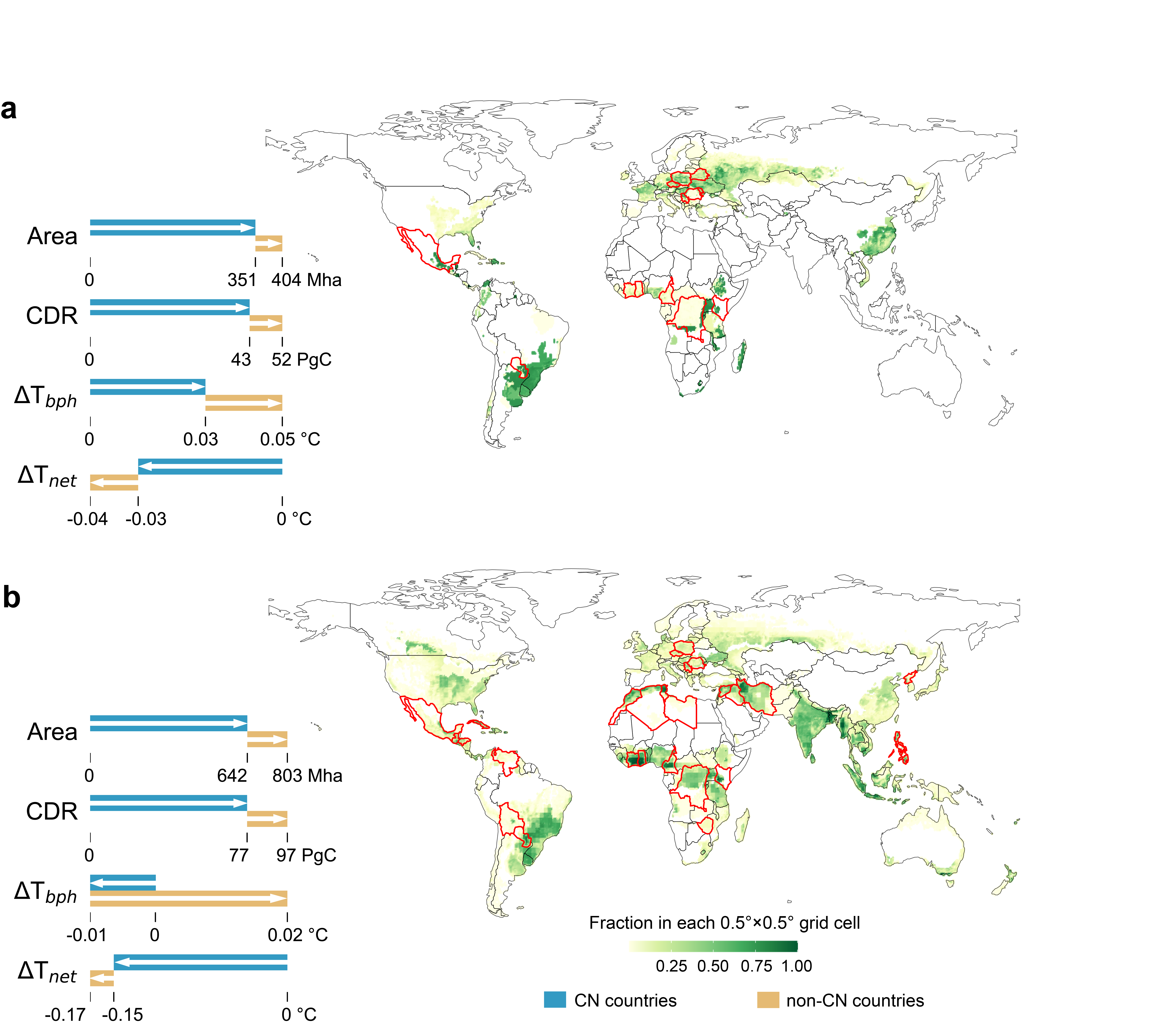Bioenergy with Carbon Capture and Storage (BECCS), as a key technology for global carbon neutrality, functions through a fundamental principle which revolves around planting bioenergy crops, leveraging their rapid growth characteristics to absorb and fix carbon dioxide from the atmosphere, converting the harvested biomass into energy, and capture and sequestration of the CO2 emissions generated in the process. At present, the evaluation of the large-scale planting effect of bioenergy crops is mostly based on the assumption of global coordinated planting, but in reality, the planting of bioenergy crops in various countries may not be promoted simultaneously. In addition, the feedback effect of bioenergy crops planted around the world on the change of land net temperature involves a complex nonlinear process, and it cannot be simply allocated according to the proportion of planting area.
Addressing the above problem, Associate Professor Li Wei’s Research Group of the Department of Earth System Science (DESS) has conducted research in collaboration with several research institutions at home and abroad. Based on whether countries have set a carbon neutrality (CN) target, all the countries in the world are classified into countries with a CN target (CN-countries) and countries without a CN target (non-CN countries). CN countries tend to promote large-scale planting of bioenergy crops, while non-CN countries, due to the lack of a definite mitigation commitment, are less likely to deploy relevant actions.
The research team quantified the contribution of large-scale bioenergy crop planting in CN-countries and non-CN countries to global climate change mitigation by means of differential simulation, and discussed the impact of the distribution and planting area of different planting regions on carbon cycle and biophysical temperature change. In this research, the biogeochemical effects of bioenergy crop planting were simulated by using a dynamic global vegetation model including independently developed bioenergy crop modules and a simplified Earth system model. At the same time, the biophysical temperature effect of bioenergy crop planting was quantitatively evaluated by coupling the model with the atmospheric model. The results show that just planting switchgrass (a representative bioenergy crop) alone in CN-countries can contribute 43~78 PgC net carbon-dioxide removal (CDR) to the world by 2100. On this basis, if non-CN countries choose to plant further, they can also contribute an additional 9 ~ 20 PgC; This net carbon removal will produce a cooling effect of 0.01~0.02℃ through biogeochemical effects, and the contribution ratio will exceed the proportion of planting area in these countries (14~20%). Although this biogeochemical cooling effect will be partially offset by the biophysical warming effect, the planting of non-CN countries still contributes additional cooling benefits to the global land (Fig. 1). The research shows that the climate mitigation potential of non-CN countries will provide important support for the realization of global climate goals. In the future process of popularizing and implementing BECCS technology, countries should bolster cooperation, tailor the planting strategy of bioenergy crops to regional characteristics, and coordinate efforts to address biophysical warming effects, thereby facilitating the achievement of global climate goals.

Fig. 1: Bioenergy crop cultivation maps and contributions of CN and non-CN countries to global climate mitigation (the non-CN countries with a cultivation area > 1 ha are marked in red).
The above results have been recently published in the journal Nature Communications in the form of a paper titled "Contributions of countries without a carbon neutrality target to limit global warming". Zhou Jiaxin, a Class 2022 doctoral student of the Tsinghua DESS, is the first author of the paper, and Associate Professor Li Wei is the corresponding author. Collaborators include Professor Philippe Ciais of Laboratoire des Sciences du Climat et de l’Environnement (LSCE), Researcher Thomas Gasser of the International Institute of Applied Systems Analysis (IIASA), Associate Professor Li Zhao of China Agricultural University, Assistant Researcher He Jiaying of the Institute of Geographic Sciences and Natural Resources Research, Chinese Academy of Sciences, and Professor Liu Li and Professor Huang Xiaomeng, doctoral graduates Wang Jingmeng, postdoctoral fellows Han Mengjie and Sun Minxuan and doctoral student Lei Zhu of Tsinghua DESS. The research was funded by the National Natural Science Foundation of China, the Tsinghua University Initiative Scientific Research Program, and the Yunnan Provincial Science and Technology Project at Southwest United Graduate School, among others.
Full-text link: https://www.nature.com/articles/s41467-024-55720-x
Written by Zhou Jiaxin
Edited by Wang Jiayin
Reviewed by Zhang Qiang